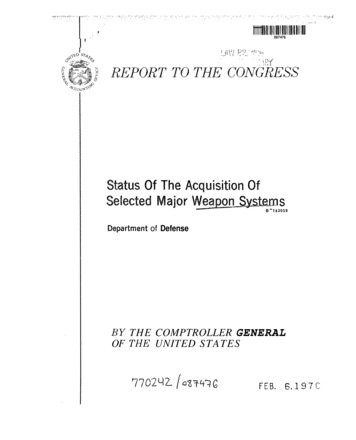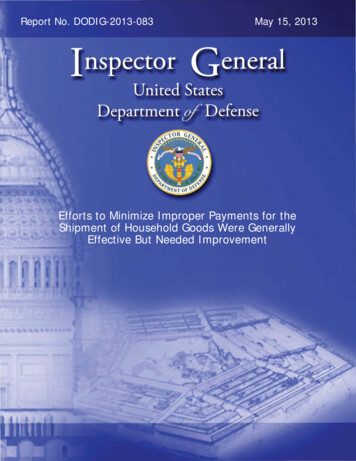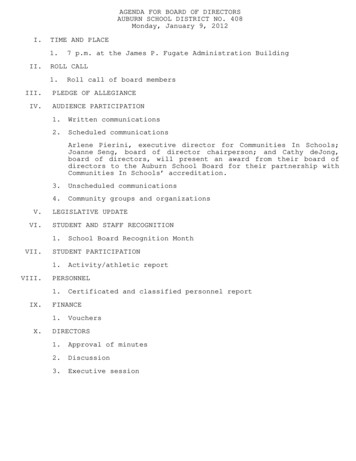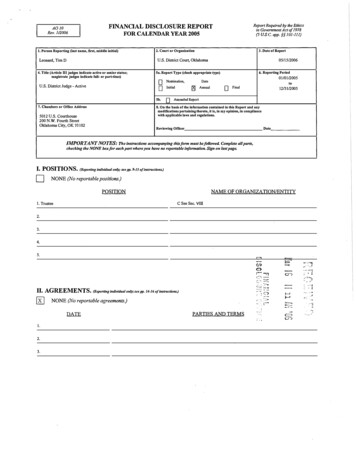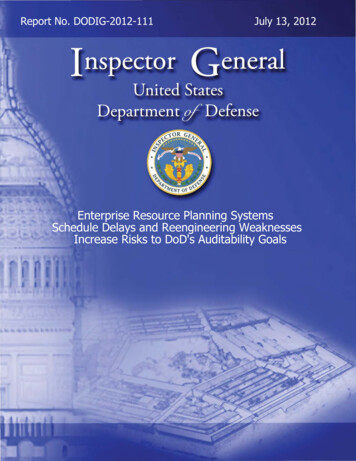
Transcription
Report No. DODIG-2012-111July 13, 2012Enterprise Resource Planning SystemsSchedule Delays and Reengineering WeaknessesIncrease Risks to DoD's Auditability Goals
Additional CopiesTo obtain additional copies of this report, visit the Web site of the Department of DefenseInspector General at http://www.dodig.mil/audit/reports or contact the Secondary ReportsDistribution Unit at (703) 604-8937 (DSN 664-8937) or fax (571) 372-7466.Suggestions for AuditsTo suggest or request audits, contact the Office of the Deputy Inspector General forAuditing by phone (703) 604-9142 (DSN 664-9142), by fax (571) 372-7466, or by mail:Department of Defense Office of Inspector GeneralOffice of the Deputy Inspector General for AuditingATTN: Audit Suggestions/13F25-044800 Mark Center DriveAlexandria, VA 22350-1500Acronyms and FEBSLMPOIGPMOSFISUSD(C)/CFO, DoDUSSGLBusiness Process ReengineeringChief Management OfficerDefense Agencies InitiativeDeputy Chief Management OfficerDefense Enterprise Accounting and Management SystemDefense Logistics AgencyEnterprise Business SystemEnergy ConvergenceEnterprise Resource PlanningFinancial Improvement and Audit ReadinessGovernment Accountability OfficeGeneral Fund Enterprise Business SystemLogistics Modernization ProgramOffice of Inspector GeneralProgram Management OfficeStandard Financial Information StructureUnder Secretary of Defense (Comptroller)/Chief FinancialOfficer, DoDU.S. Standard General Ledger
INSPECTOR GENERALDEPARTMENT OF DEFENSE4800 MARK CENTER DRIVEALEXANDRIA, VIRGINIA 22350-1500July 13, 2012MEMORANDUM FOR UNDER SECRETARY OF DEFENSE (COMPTROLLER)/CHIEFFINANCIAL OFFICER, DODDOD DEPUTY CHIEF MANAGEMENT OFFICERASSISTANT SECRETARY OF THE AIR FORCE (FINANCIALMANAGEMENT AND COMPTROLLER)NAVAL INSPECTOR GENERALAUDITOR GENERAL, DEPARTMENT OF THE ARMYSUBJECT: Enterprise Resource Planning Systems Schedule Delays and Reengineering WeaknessesIncrease Risks to DoD’s Auditability Goals (Report No. DODIG-2012-111)We are providing this report for your review and comment. We conducted this audit in response to acongressional request. DoD plans to spend more than 15 billion to develop and implement EnterpriseResource Planning systems. Schedule delays and cost increases for the systems have resulted in DoDcontinuing to use outdated legacy systems and diminish the estimated savings associated withtransforming business operation through business system modernization. In addition, the impact ofschedule delays increases the risk that DoD will not achieve an auditable Statement of BudgetaryResources by FY 2014 or accomplish its goal of full financial statement audit readiness by FY 2017. Weconsidered management comments on a draft of this report in preparing the final report.DoD Directive 7650.3 requires that recommendations be resolved promptly. The comments from theUnder Secretary of Defense (Comptroller)/Chief Financial Officer, DoD, were responsive and we do notrequire additional comments. The DoD Deputy Chief Management Officer did not respond to the draftreport. Therefore, we request the DoD Deputy Chief Management Officer provide comments onRecommendations B.1.a and B.1.b by August 13, 2012. The Chief Management Officers of the Army,Navy, and Air Force provided comments. The comments from the Chief Management Officer of theNavy were responsive, and we do not require additional comments. The comments from the ChiefManagement Officers of the Army and the Air Force were partially responsive. Therefore, we request theChief Management Officers of the Army and Air Force provide additional comments onRecommendations B.1.a and B.1.b by August 13, 2012.Please provide comments that conform to the requirements of DoD Directive 7650.3. If possible, send aportable document format (.pdf) file containing your comments to audcleve@dodig.mil. Commentsprovided to the final report must be marked and portion-marked, as appropriate, in accordance with DoDManual 5200.01. Copies of management comments must contain the actual signature of the authorizingofficial. We are unable to accept the /Signed/ symbol in place of the actual signature. If you arrange tosend classified comments electronically, you must send them over the SECRET Internet Protocol RouterNetwork (SIPRNET).We appreciate the courtesies extended to the staff. Please direct questions tome at (703) 604-8905.Amy J. Frontz, CPAPrincipal Assistant Inspector Generalfor Auditing
Report No. DODIG-2012-111 (Project No. D2012-D000DE-0057.000)July 13, 2012Results in Brief: Enterprise ResourcePlanning Systems Schedule Delays andReengineering Weaknesses Increase Risksto DoD’s Auditability Goalsaccuracy, completeness, and reliability of theProgram Management Office submissions. As aresult, there is an increased risk the ERPsystems will incur additional delays and costincreases to ensure the systems are asstreamlined and efficient as possible.What We DidWe conducted this audit in response to acongressional request. Our overall objectivewas to evaluate six Enterprise ResourcePlanning (ERP) systems that we identified asnecessary for DoD to produce auditablefinancial statements.What We RecommendWe recommend that the DoD DCMO andCMOs of the Army, Navy, and Air Force,develop procedures to review businessprocesses and limit funding to programs that arenot demonstrating adequate business processreengineering.What We FoundThe six ERP systems experienced cost increasesof 8.0 billion and schedule delays ranging from1.5 to 12.5 years during system developmentand implementation. As a result of the scheduledelays, DoD will continue using outdated legacysystems and diminish the estimated savingsassociated with transforming businessoperations through business systemmodernization. In addition, the impact ofschedule delays increases the risk that DoD willnot achieve an auditable Statement of BudgetaryResources by FY 2014 or accomplish its goal offull financial statement audit readiness byFY 2017.In addition, we recommend that the UnderSecretary of Defense (Comptroller)/ChiefFinancial Officer (USD(C)/CFO), DoD, updatethe Financial Improvement and Audit ReadinessPlan to link material weaknesses’ resolutions toDoD ERP systems and track the effect of DoDERP systems on DoD’s goals of obtainingauditable financial statements.Management Comments andOur ResponseThe DoD Deputy Chief Management Officer(DCMO) and the Chief Management Officers(CMO) of the Military Departments (DoDofficials) did not verify that business processeswere streamlined and efficient as required byPublic Law 111-84, “National DefenseAuthorization Act For Fiscal Year 2010,”Section 1072, “Business ProcessReengineering,” October 28, 2009. Thisoccurred because DoD officials relied on theProgram Management Offices’ self complianceassertions when they certified and approvedfunding of 302.7 million, instead of reviewingthe business processes and verifying theThe DoD DCMO did not respond to the draftreport. The USD(C)/CFO, DoD, and the CMOsof the Army, Navy, and Air Force agreed withour recommendations; however, the Army andAir Force CMOs did not address correctiveactions. Therefore, we request the DoD DCMO,provide comments and the CMOs of the Armyand Air Force provide additional comments.Please see the recommendations table on theback of this page. In addition, the Navy ERPProgram Management Office providedcomments on the finding discussion.i
Report No. DODIG-2012-111 (Project No. D2012-D000DE-0057.000)July 13, 2012Recommendations TableManagementUnder Secretary of Defense(Comptroller)/Chief FinancialOfficer, DoDDoD Deputy Chief ManagementOfficerChief Management Officer of theArmyChief Management Officer of theNavyChief Management Officer of theAir ForceRecommendationsRequiring CommentNo Additional CommentsRequiredB.2.a, B.2.bB.1.a, B.1.bB.1.a, B.1.bB.1.a, B.1.bB.1.a, B.1.bPlease provide comments by August 13, 2012.ii
Table of ContentsIntroductionObjectivesDoD Deputy Chief Management Officer and Chief ManagementOfficers of the Military Departments Responsibilities forBusiness System ModernizationFinancial Improvement and Audit Readiness Plan Dependence onEnterprise Resource Planning SystemsBackground on Enterprise Resource Planning SystemsReview of Internal ControlsFinding A. DoD Cost Increases and Schedule Delays Incurred in EnterpriseResource Planning Development and Implementation1112245Government Accountability Office Work Related to DoD Enterprise ResourcePlanning Costs and Schedules7Management Comments on the Finding and Our Response8Finding B. Deputy Chief Management Officer and Chief Management OfficersNeed to Verify Program Management Office Self Compliance Assertions10Section 1072 of the FY 2010 National Defense Authorization ActGuidance for the Implementation of Section 1072 - BusinessProcess ReengineeringBusiness Process Reengineering Assessment Packages Need ReviewBusiness Process Reengineering Has a Direct Impact on FinancialStatement Readiness GoalsManagement Comments on the Finding and Our ResponseRecommendations, Management Comments, and Our Response101011131415AppendicesA. Scope and MethodologyCostScheduleCompliance With Section 1072OversightUse of Computer-Processed DataPrior Coverage18181819191919
Table of Contents (cont’d)Appendices (cont’d)B. DoD Enterprise Resource Planning Systems Not Included in This AuditArmyNavyAir ForceC. Enterprise Resource Planning Systems Problems Identified inPrior DoD Office of Inspector General and GovernmentAccountability Office Audit Reports2121212223Management CommentsUnder Secretary of Defense (Comptroller)/Chief Financial Officer, DoDCommentsDepartment of the Army CommentsDepartment of the Navy CommentsDepartment of the Air Force Comments27293136
IntroductionObjectivesThis audit was in response to a September 13, 2011, congressional request related to theincreasing costs and delayed schedules of some of the DoD Enterprise Resource Planning(ERP) systems. The Government Accountability Office (GAO) previously reported DoDdid not follow best practices for estimating ERP schedules and cost, resulting inunreliable estimates. The requestors wanted to determine whether the investment in ERPsystems would result in reliable information and auditable financial statements andrecords.Our overall objective was to evaluate the ERP systems identified as necessary for DoD toproduce auditable financial statements. Specifically, we determined: changes in cost of the ERP systems during development and implementation;the impact of schedule changes on DoD’s goal to become auditable by 2017;compliance with Public Law 111-84, “National Defense Authorization Act ForFiscal Year 2010,” Section 1072, “Business Process Reengineering,”October 28, 2009, (Section 1072); andwhether the Deputy Chief Management Officer (DCMO) of the DoD, and ChiefManagement Officers (CMOs) of the Military Departments (DoD officials)provided sufficient oversight during development and implementation of the ERPsystems.In February 2012, we met with the congressional requestors to discuss the status of theERP systems audit work and agreed to obtain information from DoD on the reasons forthe cost increases and schedule delays.See Appendix A for a discussion of the scope and methodology and prior audit coverage.DoD DCMO and CMOs of the Military DepartmentsResponsibilities for Business System ModernizationThe DCMO is the Principal Staff Assistant and advisor to the Secretary of Defense andDeputy Secretary of Defense for matters relating to the management and improvement ofintegrated DoD business operations. DoD formally established the DCMO throughDoD Directive 5105.82, October 17, 2008. As part of this Directive, the Departmentassigned the responsibility for better synchronizing, integrating, and coordinating thebusiness operations of the DoD to the DCMO to ensure optimal alignment in support ofthe warfighting mission. The Directive also gave specific duties in the areas of strategicplanning, performance management, process improvement, and defense business systemsoversight to the DCMO. Since that time, the DCMO’s responsibilities have continued togrow. In addition to its normal duties, the DCMO collaborates with the CMOs of theMilitary Departments in identifying common issues relating to the management and1
improvement of business operations within and among their respective Departments.Each CMO is responsible for developing a comprehensive business transformation plan.The plan is required to track progress toward achieving an integrated system for businessoperations. In addition, Public Law 110-417, “Duncan Hunter National DefenseAuthorization Act For Fiscal Year 2009,” Section 908, “Business TransformationInitiatives for the Military Departments,” October 14, 2008, required CMOs to develop awell-defined enterprise-wide business systems architecture and transition planencompassing end-to-end business processes capable of providing accurate and timelyinformation in support of business decisions of the military department.Financial Improvement and Audit Readiness PlanDependence on ERP SystemsThe Financial Improvement and Audit Readiness (FIAR) Plan states that it is the DoDroadmap to fix internal controls, correct processes, and obtain an unqualified auditopinion. The 2011 FIAR Plan discussed the challenge of meeting the DefenseSecretary’s new goals of audit readiness of the Statement of Budgetary Resources byFY 2014 and audit readiness for all DoD financial statements by FY 2017. The “NationalDefense Authorization Act of 2010,” October 28, 2009, requires DoD financialstatements to be validated as ready for audit not later than September 30, 2017. TheFIAR Plan states that the key to achieving Federal Financial Management ImprovementAct compliance, and for most of the DoD Components to producing auditable financialstatements, is the modernization of the DoD’s business and financial systemsenvironment. The FIAR Plan also states that modernization includes the deployment ofERP systems and the retirement of hundreds of legacy systems. The FIAR Planintegrates solutions, such as upgraded systems with improvements to processes; however,the FIAR Plan does not specifically align ERP systems being implemented withachieving the audit readiness deadlines. The importance of ERP systems on auditabilityhas consistently been reported in the FIAR Plans. For instance, the 2006 FIAR Planidentifies 11 material weaknesses1 identified by DoD Office of Inspector General (OIG)audits. Of the 11 identified, 6 are to be resolved by effectively implementing 1 or moreERP systems. The FIAR Plan also states that achieving an opinion on the DoDConsolidated Financial Statements will not occur until the Department successfullydeploys numerous new finance and business systems. The guidance for the FIAR Planstates that reporting entities implementing the ERP systems as a solution for resolvingaudit impediments should map known processes and control weaknesses to the newsystems’ requirements to ensure that the systems will adequately address theimpediments.Background on ERP SystemsThe DoD OIG identified the following six ERP systems that are needed to enable theDepartment to produce auditable financial statements: General Fund Enterprise BusinessSystem (GFEBS), Logistics Modernization Program (LMP), Defense EnterpriseAccounting and Management System (DEAMS), Defense Agencies Initiative (DAI),1Material weaknesses are a reportable condition, or combination of reportable conditions, that results inmore than a remote likelihood that a material misstatement of the financial statements, or other significantfinancial reports, will not be prevented or detected.2
Navy ERP, Enterprise Business System (EBS)-Energy Convergence (EC), and EBSEProcurement2. DoD implemented other ERP systems; however, during this audit, wedid not review the ERP systems identified in Appendix B. Background information forthe six systems reviewed is discussed below. GFEBS was an Army financial management system developed to improve thetimeliness and reliability of financial information and to obtain an audit opinion.LMP was the Army’s core initiative to achieve the Single Army LogisticsEnterprise vision. LMP’s objective was to provide integrated logisticsmanagement capability by managing the supply, demand, asset availability,distribution, data retention, financial control, and reporting.DEAMS was approved as a joint U.S. Transportation Command, Defense Financeand Accounting Service, and Air Force project to replace legacy systems.DEAMS is the Air Force’s target accounting system designed to provide accurate,reliable, and timely financial information.DAI was an initiative to transform the budget, finance, and accounting operationsof the Defense agencies to achieve accurate and reliable financial information.During this audit, DAI was used across eight agencies in DoD.Navy ERP was an integrated business management system implemented to updateand standardize Navy business operations, provide financial transparency acrossthe enterprise, and increase effectiveness and efficiency.EBS was originally called the Business Systems Modernization, a SAP3 supplychain and logistics capability module utilized by the Defense Logistics Agency(DLA). DLA implemented its current ERP system through functionality basedenhancements as separate acquisition programs. DLA combined the first threeenhancements; Business Systems Modernization, Customer RelationshipManagement, and Product Data Management Initiative into what is now referredto as the EBS-Core, which reached full deployment decision in 2007. DLA beganto add enhancements to the EBS-Core and each enhancement was considered aseparate program with separate funds. When the enhancement reachedsustainment, ongoing costs for the sustainment were incorporated into theEBS-Core; however, original development, implementation, and phase-out costswere not incorporated into the core. EProcurement and EC were the twoenhancements not fully deployed and included business process reengineering(BPR) efforts that have costs of more than 100 million.o EBS-EC was an enhancement program extending the EBS-Core supplychain capabilities.o EBS-EProcurement was an enhancement program extending EBS toprovide a single tool for contract writing and administration forconsumables and service.2EBS-EC and EBS-EProcurement are two acquisition programs to develop enhancements to EBS;however, we consider EBS one system for purposes of this audit.3SAP stands for “Systems, Applications, and Products in Data Processing.” The SAP Corporation is themarket leader in enterprise application software.3
Table 1 provides more details on the status of the ERP systems.Table 1. System BackgroundSystem NameArmyGFEBSLMPNavyNavy alDeploymentDateCurrentNumber ofSystemUsersPlannedNumber ofSystem UsersPlannedNumber ofLegacySystems to nown*1,50094,0007004,0001573* Cannot identify the number of EC users because they are not individually identified in SAP.Review of Internal ControlsDoD Instruction 5010.40, “Managers’ Internal Control Program (MICP) Procedures,”July 29, 2010, requires DoD organizations to implement a comprehensive system ofinternal controls that provides reasonable assurance that programs are operating asintended and to evaluate the effectiveness of the controls. We identified an internalcontrol weakness. DoD officials relied on self compliance assertions when they certifiedand approved funding for ERP systems, instead of reviewing the business processes andverifying the accuracy, completeness, and reliability of the submissions.We will provide a copy of the final report to the senior officials responsible for internalcontrols in the Offices of the DoD Deputy Chief Management Officer, and ChiefManagement Officers of the Army, Navy, and Air Force.4
Finding A. DoD Cost Increases andSchedule Delays Incurred in ERPDevelopment and ImplementationFor the six ERP systems, DoD experienced life-cycle cost increases of 8.0 billion andschedule delays ranging from 1.5 to 12.5 years during system development andimplementation. The Program Management Offices (PMOs) provided explanations forthe cost increases and schedule delays as detailed below.GFEBS - GFEBS PMO personnel stated that costs increased as a result ofdifferent inflation factors applied to each estimate. In addition, current estimatesinclude additional costs for GEFBS that were not budgeted for in the Milestone AEconomic Analysis; schedule delays occurred because the initial schedule wasoverly aggressive, subject matter expert participation was inconsistent, and theBusiness Transformation Agency4 added new requirements.LMP - LMP PMO personnel stated that cost increases and schedule delaysoccurred as a result of unanticipated complexities associated with implementing acommercial-off-the-shelf software solution of this magnitude. LMP wasoriginally developed under a service contract, fully deployed as of October 2010,and in sustainment as of November 2011. The Acting Under Secretary ofDefense for Acquisition, Technology, and Logistics, signed an acquisitiondecision milestone on December 27, 2011, that moved LMP into Increment 2 withthe intent of improving logistics capabilities while also improving reliability offinancial information and related auditable financial statements.Navy ERP - Navy ERP PMO personnel stated that cost increases and scheduledelays resulted from 2005 base realignment and closure decisions, newrequirements, a need for increased onsite support, increased sustainment costsnecessary to maintain acceptable service levels, and Office of the Secretary ofDefense staffing issues.DEAMS - DEAMS PMO personnel stated that cost increases resulted fromschedule changes, unknown and refined requirements; schedule delays occurredas a result of the complexity of re-engineering business processes; designing,developing, and testing modifications to the commercial-off-the-shelf replacementsystem; and addressing more than 3,400 problem reports documented duringtesting.DAI - DAI PMO personnel stated cost increases and schedule delays resultedfrom adapting unique mission requirements to the commercial-off-the-shelfreplacement system. In addition, the PMO assumed the role of systems’4The Secretary of Defense disestablished the Business Transformation Agency on October 1, 2011.However, its core functions were incorporated into the Office of the DCMO and its direct programmanagement responsibilities for specific enterprise defense business systems in the DLA.5
integrator and replaced the original systems’ integration contractor with multiplecontractors. The PMO also increased data migration tools and used moreresources for BPR efforts and training than initially planned. PMO personnel alsostated that agencies using DAI requested delayed implementation as a result ofbase realignment and closure activities.EBS - EBS PMO personnel stated that cost increases resulted from scheduleslippages related to base realignment and closure decisions. They also stated thata “strategic pause” occurred in the program from February through June 2008 as aresult of DLA reprioritizing their information technology priorities andreprogramming funds planned for EC. In addition, the Systems Integratorcontract, awarded in November 2009, was protested and resulted in a stop workorder. The protest was resolved, but the stop work order was not lifted untilJune 2010. PMO personnel stated that some system modules were delayedbecause they relied on program upgrades and enhancements that were requiredbefore the implementation of the new module.As a result of the schedule delays, DoD will continue using outdated legacy systems anddiminish the estimated savings associated with transforming business operations throughbusiness system modernization. In addition, theSchedule delays increase the riskimpact of schedule delays increases the risk thatthat DoD will not achieve anDoD will not achieve an auditable Statement ofauditable Statement of BudgetaryBudgetary Resources by FY 2014 or accomplishResources by FY 2014 its goal of full financial statement audit readinessby FY 2017. The following tables identify changes in cost and schedule for the sixsystems reviewed.Table 2. Cost ChangesSystem NameOriginal Life-Cycle CostEstimate( in millions)Current Life-Cycle CostEstimate( in millions)1Difference( inmillions)ArmyGFEBSLMP2 1,353.9 420.9 1,425.34,359.7 71.43,938.8NavyNavy ERP 1,632.92,237.3604.4Air-ForceDEAMS2 419.92,158.91,739.0 209.2 2,134.8 13.8 7,248.1 2Information as of February 24, 2012.Cost includes increments 1 and 2; however, only Increment 1 was baselined.6 8,000.0
Table 3. Schedule ChangesSystem NameOriginalFull DeploymentCurrentFull Deployment*DifferenceDecember 2009June 2004July 2012September 20162.5 years12.5 yearsNavyNavy ERPJune 2011August 20132.0 yearsAir-ForceDEAMSOctober 2009April 20177.5 yearsDoDDAIEBS-CoreEBS-ECEBS-EProcurementOctober 2011October 2005October 2012October 2011January 2016July 2007June 2014September 20134.5 years2.0 years1.5 years2.0 yearsArmyGFEBSLMP* Information as of May 7, 2012.GAO Work Related to DoD ERP Costs and SchedulesSince 2007, GAO issued a number of reports on DoD ERP management issues for five ofthe six ERP systems in our audit. GAO’s work supports our findings related to scheduledelays and cost increases.GAO-11-53, “DOD Business Transformation: Improved Management Oversight ofBusiness System Modernization Efforts Needed,” October 7, 2010, responded tocongressional requests to, among other things, assess the scheduling and cost estimatingpractices of selected ERP systems DoD identified as essential to transforming its businessoperations. The GAO analyses of the schedules and cost estimates for four ERPprograms found that none of the programs were fully following best practices fordeveloping reliable schedules and cost estimates. The report stated:[m]ore specifically, none of the programs had developed a fullyintegrated master schedule that reflects all activities, including bothgovernment and contractor activities. In addition, none of the programsestablished a valid critical path or conducted a schedule risk analysis.We have previously reported that the schedules for [Global CombatSupport System - Marine Corps] and Navy ERP were developed usingsome of these best practices, but several key practices were not fullyemployed that are fundamental to having a schedule that provides asufficiently reliable basis for estimating costs, measuring progress, andforecasting slippages.The GAO report stated that the PMOs acknowledged the importance of the schedulingbest practices, but they stated that their ability to implement the best practices is limitedbecause of the complex ERP development process and the use of firm-fixed-pricecontracts. Firm-fixed-price contracts do not require contractors to provide detailed andtimely scheduling data, which is necessary to prepare accurate and reliable schedules.The GAO report also stated that the PMOs are responsible for preparing an integrated7
master schedule in accordance with best practices to adequately monitor and oversee theirinvestment in the modernization of DoD’s business systems.The GAO report stated that although the ERP programs were generally following costestimating best practices, the cost estimates for three of the four systems were not fullycredible because two of the systems did not include a sensitivity analysis and one of thesystems did not include a sensitivity analysis or a cost risk and uncertainly analysis. Costestimates should discuss any limitations of the analysis because of uncertaintysurrounding data and assumptions. Further, because none of the four met best practicesfor schedule estimating, none of the cost estimates could be considered credible becausethey did not assess the cost effects of schedule slippage.In a March 30, 2012, letter (GAO-12-565R) to congressional requestors, GAO providedupdated information on DoD’s reported status for each of the nine ERP systems as ofDecember 31, 2011. For the systems included in our audit, GAO reported that twosystems had additional schedule increases and two systems incurred additional costincreases since the October 2010 report. In addition, they reported that DAI still had notdeveloped a current life cycle cost estimate.In 2007, 2008, and 2009, GAO made 19 recommendations to improve the management ofDoD ERP efforts; DoD agreed with the recommendations. The 2010 report made eightadditional recommendations aimed at improving cost and schedule practices and thedevelopment of performance measures to determine whether the ERP systems’ intendedgoals are accomplished. The GAO indicated that eight recommendations made from2007 through 2009 and the eight recommendations made in the 2010 report remain open.Our objective was to gather and provide current data and reasons for cost increases andschedule delays; consequently, we are not making recommendations. However, the 2010GAO report made recommendations that address deficiencies for ERP systems. If DoDimplements these recommendations, improvements to cost and schedule practices can beachieved.Management Comments on the Finding andOur ResponseDepartment of Army Comments on DoD Cost Increases andSchedule Delays Incurred in Enterprise Resource PlanningDevelopment and ImplementationAlthough not required to comment, the Army DCMO provided comments on the findingdiscussion.The Army DCMO stated that the programs are reviewed at the Army and DoD level andalthough costs and time continue to grow, the Army is adding additional functionality,and on-track to support the DoD FY 2017 auditability target dates. The Army DCMOstated that Tables 2 and 3 overstate the schedule and
Jul 13, 2012 · B. DoD Enterprise Resource Planning Systems Not Included in This Audit 21 Army 21 Navy 21 Air Force 22 C. Enterprise Resource Planning Systems Problems Identifie




